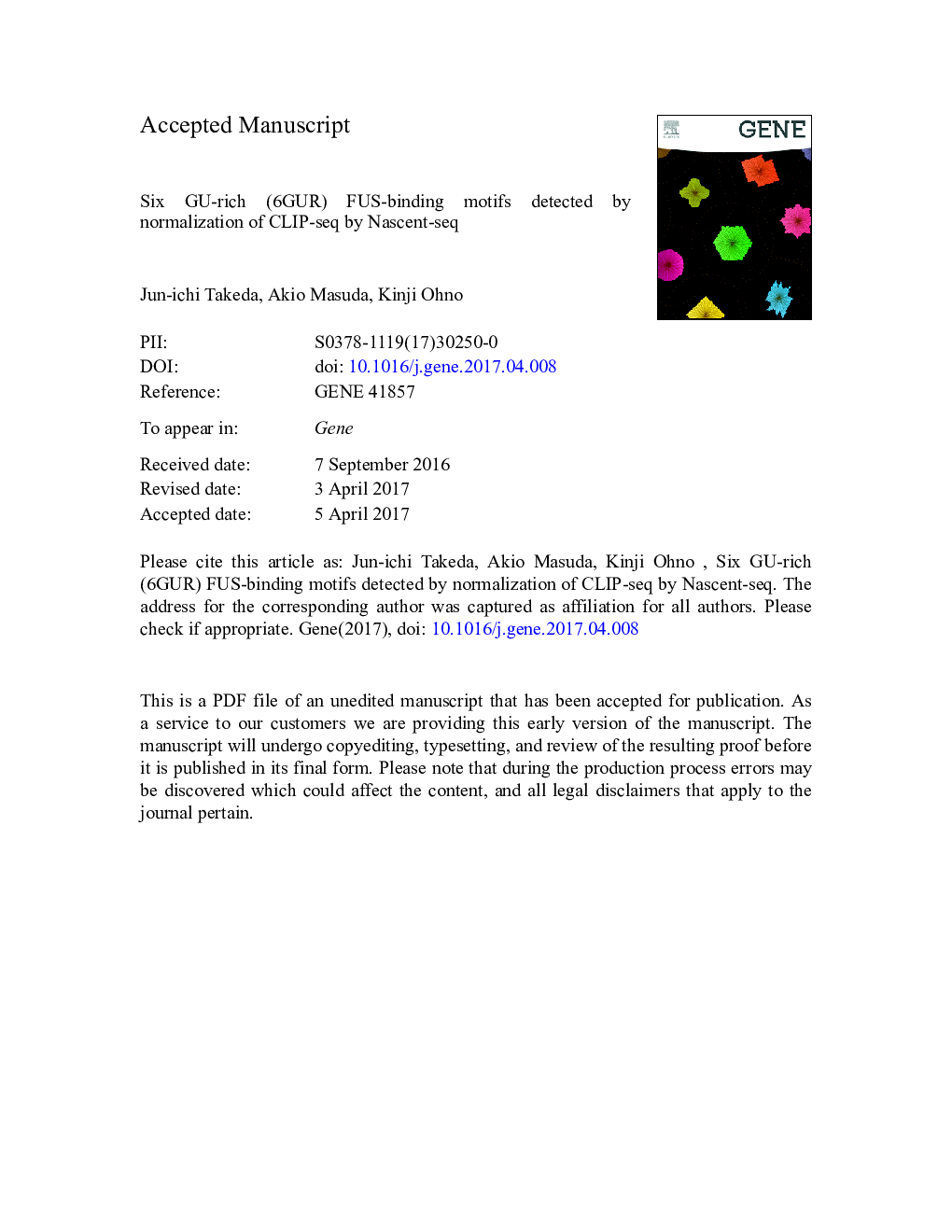| کد مقاله | کد نشریه | سال انتشار | مقاله انگلیسی | نسخه تمام متن |
|---|---|---|---|---|
| 5589582 | 1569818 | 2017 | 27 صفحه PDF | دانلود رایگان |
عنوان انگلیسی مقاله ISI
Six GU-rich (6GUR) FUS-binding motifs detected by normalization of CLIP-seq by Nascent-seq
دانلود مقاله + سفارش ترجمه
دانلود مقاله ISI انگلیسی
رایگان برای ایرانیان
موضوعات مرتبط
علوم زیستی و بیوفناوری
بیوشیمی، ژنتیک و زیست شناسی مولکولی
ژنتیک
پیش نمایش صفحه اول مقاله

چکیده انگلیسی
FUS, an RNA-binding protein (RBP), is mutated or abnormally regulated in neurodegenerative disorders. FUS regulates various aspects of RNA metabolisms. FUS-binding sites are rich in GU contents and are highly degenerative. FUS-binding motifs of GGU, GGUG, GUGGU and CGCGC have been previously reported. These motifs, however, are applicable to a small fraction of FUS-binding sites. As CLIP-seq tags are enriched in genes that are highly expressed, we normalized CLIP-seq tags by Nascent-seq tags or RNA-seq tags of mouse N2a cells. Nascent-seq identifies nascent transcripts before being processed for splicing and polyadenylation. We extracted frequently observed 4-nt motifs from Nascent-seq-normalized CLIP regions, RNA-seq-normalized CLIP regions, and native CLIP regions. Specific GU-rich motifs were best detected in Nascent-seq-normalized CLIP regions. Analysis of structural motifs using Nascent-seq-normalized CLIP regions also predicted GU-rich sequence forming a stem structure. Sensitivity and specificity were calculated by examining whether the extracted motifs were present at the cross-linking-induced mutation sites (CIMS), where FUS was directly bound. We found that a combination of six motifs (UGUG, CUGG, UGGU, GCUG, GUGG, and UUGG), which were extracted from Nascent-seq-normalized CLIP-regions, had a better discriminative power than (i) motifs extracted from RNA-seq-normalized CLIP regions, (ii) motifs extracted from native CLIP regions, (iii) previously reported individual motifs, or (iv) 15 motifs in SpliceAid 2. Validation of the 6 GU-rich (6GUR) motifs using CLIP-seq of the cerebrum and the whole brain showed that the 6GUR motifs were specifically enriched in CIMS. The number of the 6GUR motifs in an uninterrupted region was counted and multiplied by four to calculate the area, which was defined as the 6GUR-Score. The 6GUR-Score of 8 or more best discriminated CIMS from CIMS-flanking regions. We propose that the 6GUR motifs predict FUS-binding sites more efficiently than previously reported individual motifs or 15 motifs in SpliceAid 2.
ناشر
Database: Elsevier - ScienceDirect (ساینس دایرکت)
Journal: Gene - Volume 618, 30 June 2017, Pages 57-64
Journal: Gene - Volume 618, 30 June 2017, Pages 57-64
نویسندگان
Jun-ichi Takeda, Akio Masuda, Kinji Ohno,